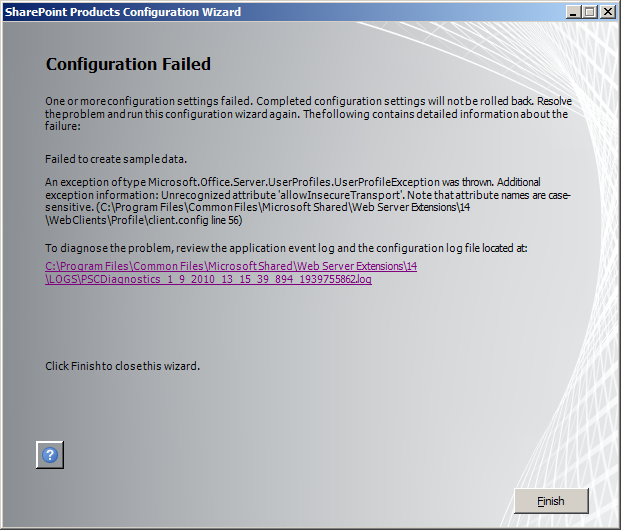I napotkał następujący błąd podczas uruchamiania kreatora konfiguracji dla SharePoint 2010.
Należy zainstalować poprawkę dla systemu Windows Server 2008 R2 / Windows 7. Do pobrania tutaj z Microsoft Connect.

Błąd w pliku dziennika:
01/09/2010 13:20:05 17 ERR wyjątkiem Microsoft.Office.Server.UserProfiles.UserProfileException typ został wyrzucony. Dodatkowe informacje wyjątkiem: Nierozpoznany atrybut "allowInsecureTransport". Należy pamiętać, że nazwy atrybutów jest uwzględniana wielkość liter. (C:\Program Files Common Files Microsoft Shared Web Server Extensions 14 WebClients Profile client.config line 56)
Microsoft.Office.Server.UserProfiles.UserProfileException: Nierozpoznany atrybut "allowInsecureTransport". Należy pamiętać, że nazwy atrybutów jest uwzględniana wielkość liter. (C:\Program Files Common Files Microsoft Shared Web Server Extensions 14 WebClients Profile client.config line 56) —> System.Configuration.ConfigurationErrorsException: Nierozpoznany atrybut "allowInsecureTransport". Należy pamiętać, że nazwy atrybutów jest uwzględniana wielkość liter. (C:\Program Files Common Files Microsoft Shared Web Server Extensions 14 WebClients Profile client.config line 56)
w System.Configuration.BaseConfigurationRecord.EvaluateOne(String[] klucze, Wejście SectionInput, Boolean isTrusted, FactoryRecord factoryRecord, SectionRecord sectionRecord, parentResult Object)
w System.Configuration.BaseConfigurationRecord.Evaluate(FactoryRecord factoryRecord, SectionRecord sectionRecord, parentResult Object, getLkg Boolean, getRuntimeObject Boolean, Obiekt& wynikać, Obiekt& resultRuntimeObject)
w System.Configuration.BaseConfigurationRecord.GetSectionRecursive(configKey String, getLkg Boolean, checkPermission Boolean, getRuntimeObject Boolean, requestIsHere Boolean, Obiekt& wynikać, Obiekt& resultRuntimeObject)
w System.Configuration.ConfigurationSectionCollection.Get(String name)
w System.ServiceModel.Configuration.ServiceModelSectionGroup.get_Client()
w Microsoft.Office.Server.UserProfiles.MossClientBase "1.GetServiceBinding(endpointConfigurationName String)
w Microsoft.Office.Server.UserProfiles.MossClientBase "1.GetChannelFactory(endpointConfigurationName String)
w Microsoft.Office.Server.UserProfiles.MossClientBase "1.get_Channel()
w Microsoft.Office.Server.UserProfiles.MossClientBase "1.ExecuteOnChannel(operationName String, blok kodu blok kodu)
w Microsoft.Office.Server.UserProfiles.ProfilePropertyServiceClient.ExecuteOnChannel(operationName String, blok kodu blok kodu)
— Koniec śladu stosu wyjątku wewnętrznej —
w Microsoft.Office.Server.UserProfiles.ProfilePropertyServiceClient.ExecuteOnChannel(operationName String, blok kodu blok kodu)
w Microsoft.Office.Server.UserProfiles.ProfilePropertyServiceClient.GetProfileProperties()
w Microsoft.Office.Server.Administration.UserProfileApplicationProxy.RefreshProperties(Guid applicationID)
w Microsoft.Office.Server.Utilities.SPAsyncCache "2.GetValueNow(Klucz K)
w Microsoft.Office.Server.Utilities.SPAsyncCache "2.GetValue(Klucz K, Boolean asynchroniczne)
w Microsoft.Office.Server.Administration.UserProfileApplicationProxy.InitializePropertyCache()
w Microsoft.Office.Server.Administration.UserProfileApplicationProxy.Provision()
w Microsoft.SharePoint.PostSetupConfiguration.EvalModeProvisionTask.ProvisionServiceApplicationsAndProxies()
w Microsoft.SharePoint.PostSetupConfiguration.EvalModeProvisionTask.Run()
w Microsoft.SharePoint.PostSetupConfiguration.TaskThread.ExecuteTask()

Leave a Reply